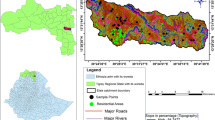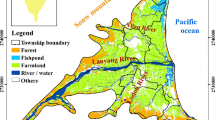Abstract
Middle Euphrates Region—Iraq (MER) is important for Iraq’s agricultural activity and production. This paper evaluated the possibility of using groundwater for irrigation in this region. This evaluation was based on computing the irrigation water quality index (IWQI) spatial distribution via the geographical information system (GIS). The IWQI distribution map was integrated with the groundwater depth, land capability, and irrigation suitability maps to classify and zone the potential of using groundwater in the MER. To this end, the weighted overlay approach was applied. Spatial analysis of the IWQI illustrated that the groundwater quality in the MER could be classified into High, Severe, and Moderate Restriction classes, each covering 62%, 33%, and 5% of the MER, respectively. Classifying the groundwater via the weighted overlay approach produces four classes with low, moderate, high, and severe restrictions. Each has a percentage of 24%, 50%, 23%, and 3%, respectively. As these results showed, most MER has groundwater that can be exploited with low to moderate restrictions. These two classes are distributed along and near the Tigris and Euphrates rivers. However, good percentages of these classes are distributed in the eastern and northwestern regions of the MER. Given the water scarcity that the MER suffers, groundwater with these classes represents a potential solution that can be employed to overcome the water shortage; nevertheless, it should not be exploited intensively as it may induce irreversible environmental impacts.



















Similar content being viewed by others
References
Abbas Drebee H, Azam Abdul-Razak N (2020) The impact of corruption on agriculture sector in Iraq: econometrics approach. IOP Conference Series: Earth and Environmental Science 553:012019. https://doi.org/10.1088/1755-1315/553/1/012019
Abdullah TO, Ali SS, Al-Ansari NA (2016) Groundwater assessment of Halabja Saidsadiq Basin, Kurdistan region, NE of Iraq using vulnerability mapping. Arab J Geosci 9(3):223. https://doi.org/10.1007/s12517-015-2264-y
Adimalla N, Venkatayogi S (2018) Geochemical characterization and evaluation of groundwater suitability for domestic and agricultural utility in semi-arid region of Basara, Telangana State. South India Applied Water Sci 8(1):44. https://doi.org/10.1007/s13201-018-0682-1
Al-Abadi AM, Al-Temmeme AA, Al-Ghanimy MA (2016) A GIS-based combining of frequency ratio and index of entropy approaches for mapping groundwater availability zones at Badra–Al Al-Gharbi–Teeb areas Iraq. Sustain Water Resour Manag 2(3):265–283. https://doi.org/10.1007/s40899-016-0056-5
Al-Ansari N, Jawad S, Adamo N, Sissakian V (2019) Water quality and its environmental implications within Tigris and Euphrates rivers. J Earth Sci Geotech Eng 9(4):57–108
Al-Ansari N, Saleh S, Abdullahand T, Abed SA (2021) Quality of surface waterand groundwater in Iraq: quality of surface waterand groundwater in Iraq. Earth Sciences Geotechnical Engineering 11(2):161–199
Ali R, Kuriqi A, Kisi O (2020) Human-environment natural disasters interconnection in china: a review. Climate 8(4):48. https://doi.org/10.3390/cli8040048
AlJawad S et al (2018) Groundwater quality and their uses in Iraq. J Earth Sci Geotech Eng 8(3):123–144
Al-Kubaisi, Q.Y., Alaa M., A.-A., Maitham A., A.-G. 2018. Mapping groundwater quality Index for irrigation in the Dibdibba aquifer at Karbala Najaf plateau, central of Iraq. Iraqi J Sci. https://doi.org/10.24996/ijs.2018.59.3C.10
Al-Mussawi WH (2014) Assessment of groundwater quality in UMM ER Radhuma Aquifer (Iraqi Western desert) by integration between irrigation water quality index and GIS. J Univ Babylon 22(1):201–217
Al-Sudani HIZ (2019) Groundwater system of Dibdibba sandstone aquifer in south of Iraq. Appl Water Sci 9(4):72. https://doi.org/10.1007/s13201-019-0952-6
Alwan I, Ziboon ART, Khalaf AG (2018) Comparison of nine meteorological drought indices over middle Euphrates region during period from 1988 To 2017. Int J Eng Tech. 7(4.20):602–607
Ameen RFM, Mourshed M (2019) Urban sustainability assessment framework development: the ranking and weighting of sustainability indicators using analytic hierarchy process. Sustain Cities Soc 44:356–366. https://doi.org/10.1016/j.scs.2018.10.020
APHA (2017) Standard Methods for the Examination of Water and Wastewater, 2. American Public Health Association, American Water Works Association, Water Environment Federation, USA
Awadh SM, Al-Mimar H, Yaseen ZM (2021) Groundwater availability and water demand sustainability over the upper mega aquifers of Arabian Peninsula and west region of Iraq. Environ Dev Sustain 23(1):1–21. https://doi.org/10.1007/s10668-019-00578-z
Cazzaniga R et al (2018) Floating photovoltaic plants: Performance analysis and design solutions. Renew Sustain Energy Rev 81:1730–1741. https://doi.org/10.1016/j.rser.2017.05.269
Hasab HA, Jawad HA, Dibs H, Hussain HM, Al-Ansari N (2020) Evaluation of water quality parameters in marshes zone southern of Iraq based on remote sensing and GIS techniques. Water Air Soil Pollut 231(4):183. https://doi.org/10.1007/s11270-020-04531-z
Hofstra N, Bouwman AF, Beusen AHW, Medema GJ (2013) Exploring global Cryptosporidium emissions to surface water. Sci Total Environ 442:10–19. https://doi.org/10.1016/j.scitotenv.2012.10.013
Hussein H, Conker A, Grandi M (2020) Small is beautiful but not trendy: understanding the allure of big hydraulic works in the Euphrates-Tigris and Nile waterscapes. Mediterranean Politics. https://doi.org/10.1080/13629395.2020.1799167
Islam N, Sadiq R, Rodriguez MJ (2013) Optimizing booster chlorination in water distribution networks: a water quality index approach. Environ Monit Assess 185(10):8035–8050. https://doi.org/10.1007/s10661-013-3153-z
ISO, 2006. Water quality—Sampling—Part 19: Guidance on sampling of marine sediments. International Organization for Standardization, Geneva, Switzerland. 1–14
Jarvis T, Giordano M, Puri S, Matsumoto K, Wolf A (2005) International borders ground water flow, and hydroschizophrenia. Groundw 43(5):764–770. https://doi.org/10.1111/j.1745-6584.2005.00069.x
Khalaf RM, Waqed H, H., (2013) Evaluation of irrigation water quality index IWQI for Al-Dammam confined aquifer in the west and southwest of Karbala city, Iraq. Int J Civ Eng IJCE 23:21–34
Khayyun TS, Alwan IA, Hayder AM (2019) Hydrological model for Hemren dam reservoir catchment area at the middle river Diyala reach in Iraq using ArcSWAT model. Appl Water Sci 9(5):133. https://doi.org/10.1007/s13201-019-1010-0
Kuriqi A et al (2020a) Seasonality shift and streamflow flow variability trends in central India. Acta Geophys 68(5):1461–1475. https://doi.org/10.1007/s11600-020-00475-4
Kuriqi A, Pinheiro AN, Sordo-Ward A, Garrote L (2020b) Water-energy-ecosystem nexus: balancing competing interests at a run-of-river hydropower plant coupling a hydrologic–ecohydraulic approach. Energy Convers Manage 223:113267. https://doi.org/10.1016/j.enconman.2020.113267
Mahil SK et al (2020) Psoriasis treat to target: defining outcomes in psoriasis using data from a real-world, population-based cohort study (the British Association of Dermatologists Biologics and Immunomodulators Register, BADBIR). Br J Dermatol 182(5):1158–1166. https://doi.org/10.1111/bjd.18333
Mukate S, Wagh V, Panaskar D, Jacobs JA, Sawant A (2019) Development of new integrated water quality index (IWQI) model to evaluate the drinking suitability of water. Ecol Ind 101:348–354. https://doi.org/10.1016/j.ecolind.2019.01.034
Pandey K, Kumar S, Malik A, Kuriqi A (2020) Artificial neural network optimized with a genetic algorithm for seasonal groundwater table depth prediction in Uttar Pradesh. India Sustain 12(21):8932. https://doi.org/10.3390/su12218932
Rahi KA, Halihan T (2010) Changes in the salinity of the Euphrates river system in Iraq. Reg Environ Change 10(1):27–35. https://doi.org/10.1007/s10113-009-0083-y
Rateb A, Scanlon BR, Kuo C-Y (2020) Multi-decadal assessment of water budget and hydrological extremes in the Tigris-Euphrates Basin using satellites, modeling, and in-situ data. Sci Total Environ. https://doi.org/10.1016/j.scitotenv.2020.144337
Saleh LAM (2016) Assessment of the irrigation water quality for Al-Kifl river in Al-Hindya city. J Univ Babylon 24(1):266–276
Sissakian VK, Saeed ZB (2012) Lithological map of Iraq, compiled using GIS techniques. Iraqi Bull Geol Min 8(3):1–13
Sissakian VK, Saffa FA, F. (2015) Geological map of Iraq, scale 1: 1000 000, 2012. Iraqi Bull Geol Min 11(1):9–16
Voss KA et al (2013) Groundwater depletion in the Middle East from GRACE with implications for transboundary water management in the Tigris-Euphrates-Western Iran region. W Resour Res. 49(2):904–914. https://doi.org/10.1002/wrcr.20078
Wada Y et al (2010) Global depletion of groundwater resources. Geophys Res Lett. https://doi.org/10.1029/2010GL044571
Wei W et al (2019) The effects of terracing and vegetation on soil moisture retention in a dry hilly catchment in China. Sci Total Environ 647:1323–1332. https://doi.org/10.1016/j.scitotenv.2018.08.037
Wilkinson TJ et al (2012) Late Chalcolithic and Early Bronze Age Landscapes of Settlement and Mobility in the Middle Euphrates: a Reassessment. Levant 44(2):139–185. https://doi.org/10.1179/0075891412Z.0000000007
Acknowledgements
Alban Kuriqi acknowledges the Portuguese Foundation for Science and Technology (FCT) support through PTDC/CTA-OHR/30561/2017 (WinTherface).
Author information
Authors and Affiliations
Corresponding author
Ethics declarations
Consent to participate
Yes.
Consent for publication
Yes.
Additional information
Publisher's Note
Springer Nature remains neutral with regard to jurisdictional claims in published maps and institutional affiliations.
Rights and permissions
Springer Nature or its licensor holds exclusive rights to this article under a publishing agreement with the author(s) or other rightsholder(s); author self-archiving of the accepted manuscript version of this article is solely governed by the terms of such publishing agreement and applicable law.
About this article
Cite this article
Khafaji, M.S.A., Alwan, I.A., Khalaf, A.G. et al. Potential use of groundwater for irrigation purposes in the Middle Euphrates region, Iraq. Sustain. Water Resour. Manag. 8, 157 (2022). https://doi.org/10.1007/s40899-022-00749-3
Received:
Accepted:
Published:
DOI: https://doi.org/10.1007/s40899-022-00749-3




